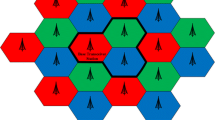Abstract
To achieve high system capacity, most fourth-generation (4G) cellular communication systems, including long term evolution (LTE), tend to adopt aggressive frequency reuse scheme. Although this scheme can increase system capacity, it has a major challenge of suffering severe intercell co-channel interference (CCI), which will reduce cell-edge user throughput and increase outage probability. In this paper, an analytical method is presented for estimating the uplink capacity reduction due to CCI in a cellular LTE network. This method is based on an interference analysis that accounts for random distribution of user locations, propagation shadow fading effect, and user-equipment output power limitations. The results indicate that CCI can cause up to 50 % reduction in throughput for cell-edge users. The proposed method is helpful for estimating the CCI impacts when building a 4G network.










Similar content being viewed by others
References
Third Generation Partnership Project (2012). 3GPP TR 36.913: Requirements for further advancements for evolved universal terrestrial radio access.
IEEE 802.16 Working Group (2011). 802.16m, part 16: Air interface for broadband wireless access systems.
Yang, K. (2012). Interference management in LTE wireless networks. IEEE Wireless Communications, 19(3), 8–9. doi:10.1109/MWC.2012.6231152.
Salem, M., Adinoyi, A., Yanikomeroglu, H., & Falconer, D. (2010). Opportunities and challenges in OFDMA-based cellular relay networks: A radio resource management perspective. IEEE Transactions on Vehicular Technology, 59(5), 2496–2510. doi:10.1109/TVT.2010.2042736.
Bhat, P., Nagata, S., Campoy, L., Berberana, L., Derham, T., Liu, G., et al. (2012). LTE-advanced: An operator perspective. IEEE Communications Magazine, 50(2), 104–114. doi:10.1109/MCOM.2012.6146489.
Fushiki, M., Ohseki, T., & Konishi, S. (2011). Throughput gain of fractional frequency reuse with frequency selective scheduling in SC-FDMA uplink cellular system. IEEE Vehicular Technology Conference. doi:10.1109/VETECF.2011.6093053.
Myung, H. G., Lim, J., & Goodman, D. J. (2006). Single carrier FDMA for uplink wireless transmission. IEEE Vehicular Technology Magazine, 1(3), 30–38. doi:10.1109/MVT.2006.307304.
Bosisio, R., & Spagnolini, U. (2008). Interference coordination vs. interference randomization in multicell 3GPP LTE system. Wireless Communications and Networking Conference. doi:10.1109/WCNC.2008.151.
Fodor, G., Koutsimanis, C., Racz, A., Reider, N., Simonsson, A., & Muller, W. (2009). Intercell interference coordination in OFDMA networks and in the 3GPP long term evolution system. Journal of Communications, 4(7), 445–453.
Porjazoski, M., & Popovski, B. (2010). Contribution to analysis of intercell interference coordination in LTE: A fractional frequency reuse case. Global Mobile Congress. doi:10.1109/GMC.2010.5634622.
Ogata, D., Aagate, A., & Fujii, T. (2012). Multi-BS cooperative interference control for LTE systems. IEEE Vehicular Technology Conference. doi:10.1109/VETECS.2012.6240265.
Fujii, H., & Yoshino, H. (2008). Theoretical capacity and outage rate of OFDMA cellular system with fractional frequency reuse. IEEE Vehicular Technology Conference. doi:10.1109/VETECS.2008.386.
Yu, Y., Dutkiewicz, E., Huang, X., & Mueck, M. (2012). A resource allocation scheme for balanced performance improvement in LTE networks with inter-cell interference. IEEE Wireless communications and Networking Conference. doi:10.1109/WCNC.2012.6214043.
Koleva, P., Asenov, O., Iliev, G., & Poulkov, V. (2012). Interference limited uplink power control based on a cognitive approach. IEEE International Conference on Telecommunications and Signal Processing. doi:10.1109/TSP.2012.6256290.
Third Generation Partnership Project (2012). 3GPP TR 36.942: Radio frequency system scenarios.
Kim, D. K., & Sung, D. K. (2001). Capacity estimation for a multicode CDMA system with SIR-based power control. IEEE Transactions on Vehicular Technology, 50(3), 701–710. doi:10.1109/25.933306.
Chen, W.-T. (2009). Adjacent channel interference in a macrocell/microcell WCDMA system. Wireless Communications and Mobile Computing, 9(2), 187–195. doi:10.1002/wcm.596.
Yates, R. D., & Goodman, D. J. (1999). Probability and stochastic processes. New York: Wiley.
Essassi, S., Siala, M., & Cherif, S. (2011). Dynamic fractional power control for LTE uplink. IEEE International Symposium on Personal, Indoor and Mobile Radio Communications. doi:10.1109/PIMRC.2011.6139775.
Author information
Authors and Affiliations
Corresponding author
Rights and permissions
About this article
Cite this article
Chen, WT. Analytic estimation for uplink capacity reduction due to co-channel interference in LTE networks. Wireless Netw 21, 1775–1782 (2015). https://doi.org/10.1007/s11276-014-0883-y
Published:
Issue Date:
DOI: https://doi.org/10.1007/s11276-014-0883-y




